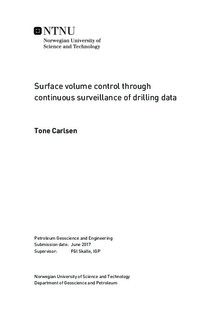| dc.description.abstract | When a new well is being drilled, volume control should be among the most important focus areas for the drilling crew. In every drilling operation, pressures exerted from the formations need to be controlled and overbalance in the well must be maintained. If any pressure barriers fail, for instance by insufficient drilling fluid density, an underbalanced situation occurs, and formation fluids will slowly start moving into the well and kicks can occur. When kicks fail to be detected by the drill crew at surface, they may develop into a disaster, where both human lives and environment are put at risk.
Lost circulation is another consequence from not maintaining the correct pressures inside the well bore. If the hydrodynamic pressure downhole becomes larger than the formation breaking pressure, fractures are induced, and drilling fluid will start flowing into the fractures, reducing volume in the tanks, and, but seldom, reducing hydrostatic pressure in the well. In a worst-case scenario, this could develop into a kick situation as well.
The first part of this master thesis considers theory related to volume control, with main focus on lost circulation and kicks, and under which circumstances they may occur. In addition, previous research relevant to loss- and influx detection by monitoring RTDD parameters on the rig, is presented. The earlier volume control problems are detected, the lower the kick volume becomes, and the more time the rig crew gets to handle the kick in an appropriate and safe way.
The main part of this thesis is related to a mathematical model that intends to describe how the active tank volume is affected by typical drilling operations on a rig. This model takes in RTDD from a well (hereby named well 1A) on the Statfjord field, and compares the observed active mud tank levels on the rig to its theoretical modelled values. By doing so, it can detect when the observed mud level is deviating from the theoretical, and thus detect possible volume control related incidents. The final well report from well 1A was used for supporting the results of the model.
When tested on a drilled interval in well 1A on the 8th of February 2006, the model managed to detect loss of mud into the formation. The losses were confirmed from the final well report in only one of the two cases. In other words, the model detected unreported losses.
For further work, several modules of the model should be updated and more parameters included. Also, it should be tested on more wells -preferably wells with kick incidents- to better check model performance abilities. A final improvement would be to make the model more user-friendly and automatic, for instance by implementing it in MATLAB. | |

